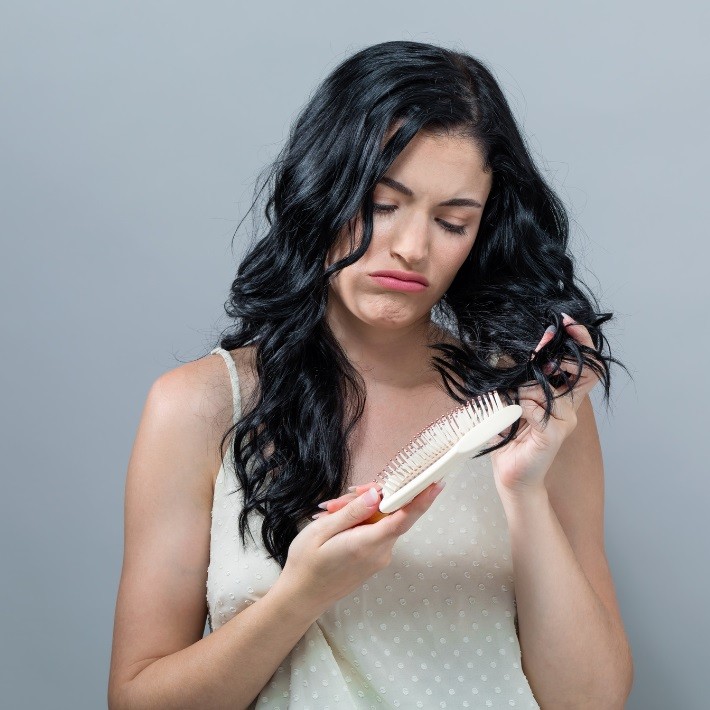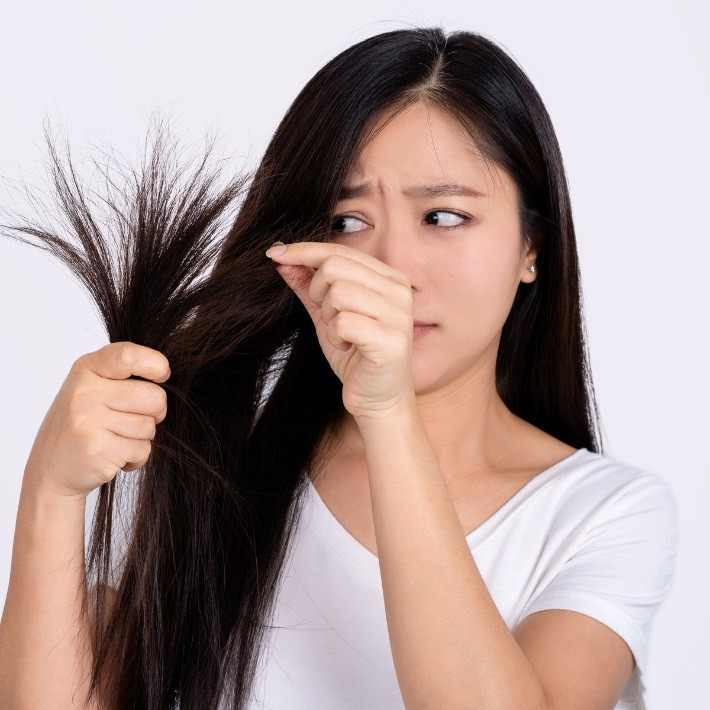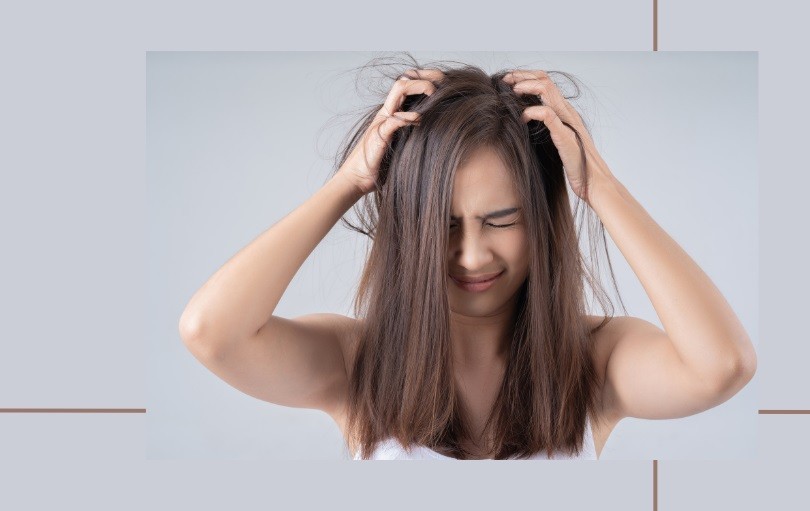Last Updated on March 28, 2025
To know if your hair is damaged, check for split ends or breakage within the first few inches of your hair. Damaged hair may also feel dry, frizzy, or lack shine.
Maintaining healthy hair habits can prevent future damage and keep your hair looking its best. With proper care and attention, you can restore your hair’s health and natural beauty. Your hair is an important part of your overall appearance, but it is vulnerable to a variety of environmental and physical factors that can cause damage. Frequent use of heated styling tools, chemical treatments, and exposure to sun, wind, and pollution can all contribute to dry, brittle, and exhausted hair. In addition, poor diet, stress, and medication can also affect the health of your hair. Identifying signs of hair damage is crucial, as early detection can help prevent further harm and promote healthy hair growth. By following a few simple tips and adopting a hair care routine tailored to your specific hair needs, you can keep your hair looking luscious and full of vitality.
Understanding Hair Damage

Hair damage can be frustrating, as it can directly impact our appearance and confidence. But before we delve into how to know if your hair is damaged, let’s first understand what hair damage is.
Related: Is Purple Shampoo Bad For Your Hair?
Definition Of Hair Damage
Hair damage refers to any disruption to the hair’s cuticle, which is responsible for protecting your hair from external aggressors like heat, chemicals and pollution. When the cuticle is damaged, the innermost layer of the hair, which contains keratin, becomes exposed, leading to dryness, brittleness, and breakage.
Common Causes Of Hair Damage
There are various causes of hair damage, some of which are preventable.
- Heat styling tools: excessive use of flat irons, curling wands and blow dryers can damage your hair cuticles and weaken your hair shaft.
- Chemical treatments: perming, relaxing and coloring treatments that contain harsh chemicals can cause damage to your hair.
- Environmental factors: overexposure to uv rays, humidity, and pollution, can lead to dryness, brittleness, and breakage.
- Poor hair care practices: aggressive brushing or combing, hair pulling, and tight hairstyles like braids or ponytails, can cause breakage and damage your hair cuticle.
Understanding what causes hair damage is crucial in preventing it from happening. By adopting a proactive hair care routine and minimizing the use of heat styling tools and chemical treatments, you can promote healthy hair growth and prevent further damage.
Signs Of Hair Damage
Maintaining healthy hair requires effort and care. Environmental factors, excessive heat application, and chemical treatments can cause damage to hair, leading to problems like split ends, hair breakage, and dull appearance. In this section, we will look at some signs that indicate your hair might be damaged.
Split Ends
Split ends are one of the most common signs of hair damage. It occurs when the protective outer layer of the hair cuticle is stripped away, exposing the fragile inner layers. Some signs of split ends include frayed hair tips, hair breakage, and an uneven hair appearance.
- Minimize split ends by trimming your hair frequently
- Avoid heat styling tools and certain hair products that can dry your hair
- Use conditioners regularly to nourish and protect your hair ends
Hair Breakage
Hair breakage can be caused by various factors, including exposure to harsh chemicals, sun damage, and improper hair care practices.
- Short hair strands
- Thinning hair
- Brittle hair that snaps easily
- Excessive shedding
To minimize hair breakage, consider the following tips:
- Be gentle when brushing your hair and avoid harsh brushing
- Protect your hair from sun damage and avoid frequent hair treatments
- Use a wide-toothed comb when detangling your hair
Dry And Dull Appearance
Another indication of hair damage is a dry and dull appearance. When the hair loses moisture, it becomes dry looking and lacks shine.
- Frizzy hair
- Split ends
- Lack of shine
- Tangled hair
To restore shine and moisture to your hair, try these tips:
- Use sulfate-free hair products
- Avoid over-washing your hair
- Use natural oils to condition your hair
- Limit heat styling tools
Tangles And Knots
Tangled and knotted hair often indicates hair damage. When the hair cuticle is damaged, the hair strands tangle and knot easily.
- Hair that easily tangles
- Knots at the end of hair strands
- Difficulty combing or brushing your hair
To minimize tangles and knots, consider these tips:
- Use a detangling spray or hair conditioner
- Brush your hair gently and avoid tugging or pulling
- Use a silk or satin pillowcase to avoid hair tangles while sleeping
Lack Of Elasticity
Hair elasticity refers to the hair’s ability to stretch and then return to its original shape without breaking. Hair damage leads to decreased hair elasticity, making the hair strands prone to breakage and brittleness.
- Hair strands that do not bounce back when pulled
- Hair strands that break easily
- Constant hair shedding
To improve hair elasticity, use these tips:
- Use hair products that contain proteins
- Use a wide-toothed comb when detangling your hair
- Avoid using tight hair accessories that can cause hair breakage
By keeping an eye out for these signs, you can identify whether your hair is damaged and take the necessary steps to restore its health. Ensure that you give your hair the care and attention it deserves to maintain its vitality and shine.
Related: Does Purple Shampoo Work On Natural Blonde Hair?
Testing For Hair Damage

If you’ve been wondering why your hair looks dull or feels like straw, it could be due to hair damage. Healthy hair looks strong, shiny, and bouncy. Hair that’s damaged lacks elasticity, looks dry and brittle, and doesn’t hold a style well.
The first step to repairing damaged hair is knowing if you indeed have it. Here are four tests you can carry out to know if your hair is damaged.
Porosity Test
The porosity of your hair refers to how well it can absorb and retain moisture. To check your hair’s porosity, take a strand of clean hair and immerse it in a bowl of water for a minute. Observe what happens to the hair.
If it sinks quickly, your hair has high porosity. If it floats on the surface, your hair has low porosity. Hair with high porosity is prone to damage, as it absorbs too much moisture, causing it to become brittle, weak, and prone to breakage.
Hair Elasticity Test
Hair elasticity refers to its ability to stretch and revert back to its natural shape. Healthy hair has optimal elasticity, meaning it can absorb stress like brushing and styling without breaking. To test your hair’s elasticity, take a strand of hair and stretch it gently.
If it snaps immediately, your hair lacks elasticity, meaning it’s dry and damaged. If it stretches without breaking and bounces back to its natural shape, your hair is healthy and has good elasticity.
Stretch Test
The stretch test is another way to check for hair damage. Take a small section of hair and stretch it gently. If it stretches and bounces back to its original length, your hair is healthy. If it stretches but doesn’t return to its initial length, your hair is damaged and needs deep conditioning treatment.
Shine Test
Dull and lifeless hair is a sign of damage. To find out if your hair is lacking shine, check it out in natural light. Healthy hair reflects light and appears shiny. Damaged hair, on the other hand, absorbs light and appears dull.
So, if your hair looks dull, lifeless, and lacks luster, you need to take care of it.
Carrying out these four tests will give you a clear idea of your hair’s state. Remember, it’s essential to maintain healthy hair, as it’s the crown you never take off. If you find out that your hair is damaged, don’t panic.
You can repair it by changing some of your hair care habits, using the right products, and deep conditioning treatments.
Related: What Does Purple Shampoo Do To Red Hair?
Preventing Hair Damage: An Ounce of Prevention…
As the old saying goes, an ounce of prevention is worth a pound of cure. Here are some strategies to keep hair damage at bay:
Protect Your Hair from the Elements
Hats, scarves, and umbrellas aren’t just fashion accessories. They also serve as shields against the harsh elements. So, the next time you step out, remember to protect your hair!
Be Gentle When Detangling
Ever tried to untie a knot by tugging at it? It only gets tighter, right? The same goes for your hair. Always detangle with a wide-tooth comb and lots of patience.
Adopt a Regular Hair Care Routine
Consistency is key when it comes to hair health. Regular deep conditioning, oiling, and massaging can keep your hair in top-notch condition.
Embrace Low Manipulation Styles
Low manipulation styles, like braids and twists, can reduce the physical stress on your hair, preventing breakage and damage.
Regular Deep Conditioning Treatments
Deep conditioning treatments nourish and hydrate your hair, helping to prevent damage before it starts.
Avoid Harsh Chemicals
Many hair products contain harsh chemicals that can strip your hair of its natural oils, leading to dryness and damage. Opting for natural, gentle products can help maintain your hair’s health and prevent damage.
Frequently Asked Questions Of How To Know If Your Hair Is Damaged?
Faq 1: What Are The Signs Of Damaged Hair?
If you notice split ends, dryness, frizziness, dullness, breakage, or hair fall, it could indicate that your hair is damaged.
Faq 2: What Causes Hair Damage?
Excessive heat styling, chemical treatments, harsh hair products, over-shampooing, poor diet, stress, and environmental factors like sun, wind, and pollution can cause hair damage.
Faq 3: Can Damaged Hair Be Repaired?
While you cannot fully repair damaged hair, you can restore its health and appearance by trimming the ends, adopting a healthy hair care routine, using nourishing and restorative hair products, and eating a balanced diet.
Faq 4: How Often Should I Wash My Damaged Hair?
You should limit your hair washes to 2-3 times a week and use sulfate-free, moisturizing shampoos.
Faq 5: How Can I Prevent Hair Damage?
You can prevent hair damage by avoiding excessive heat styling, chemical treatments, harsh hair products, over-shampooing, and protecting your hair from environmental factors like sun, wind, and pollution.
Conclusion
As we have discussed, damaged hair is a common problem that can happen due to various reasons. Understanding the signs of damaged hair is essential in order to take the necessary steps to prevent further damage. Whether it is split ends, frizz, dryness, or breakage, there are several ways to identify and treat damaged hair.
Maintaining a healthy diet, using quality hair products, and reducing heat styling can all help to prevent hair damage. Remember, prevention is always better than trying to fix the damage later on. So, pay attention to your hair’s health, take good care of it, and seek professional help when needed.
By doing so, you can regain your hair’s natural shine and beauty.

